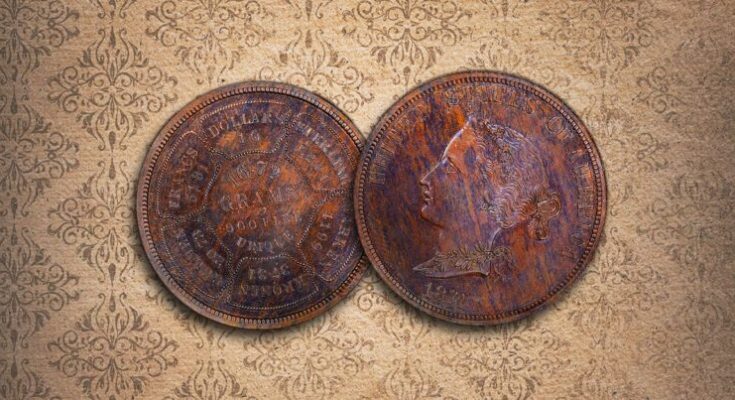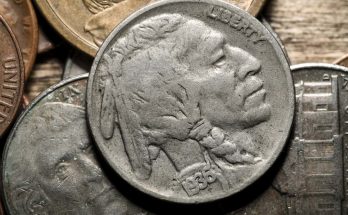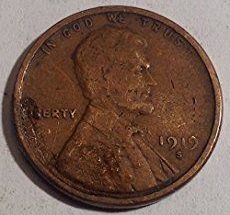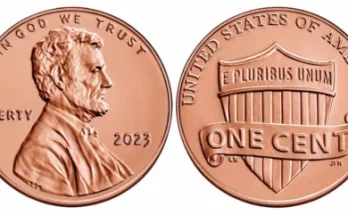The Bickford dollars were pattern coins intended for international use across multiple currencies. They were conceptualized and designed by Dana Bickford in the 1870s. Despite its innovative concept, the Bickford dollar never gained legislative approval and remained a pattern issue.
Origin and Concept of the Bickford Dollar
Dana Bickford was a businessman from New York who disliked the inconveniences caused by the currency exchange system while traveling across Europe in 1873. Upon his return to the United States, Bickford proposed a coin with global value to Dr. Henry Linderman, the Director of the U.S. Mint. Linderman approved the concept, and after designs were made, pattern coins were struck in 1874. and readily showed its value across multiple major currencies.
The experimental pattern coins Bickford envisioned were meant to serve not only as a solution for travelers but also as a bridge between different monetary systems by showing their value across multiple currencies. The concept of listing exchange values for different currencies on the coin’s reverse made it particularly innovative for global commerce. Unfortunately, the challenges posed by logistical and political norms were too great, especially when nations were divided between the gold and silver standards.
Design and Composition of the Bickford Dollar Series
The Bickford dollar was issued in $1 and $10 denominations and in numerous compositions to address the concerns posed by the bimetallism debate facing the nation at that time. It was produced in gold, silver, copper, and aluminum compositions, each with a secondary metal used for the center of the coin. The composition of Bickford dollars included:
- Aluminum with a brass center.
- Aluminum with a copper center.
- Silver with a brass center.
- Silver with a copper center.
- Gold with a brass center.
- Gold with a copper center.
- Brass with an aluminum center.
- Copper with an aluminum center.
Design of the Bickford $1 Coin
Obverse of the Bickford Dollar
The design of the Bickford Dollar reflected Bickford’s vision for a universal coin. The obverse carried an inscription: “THIS COMBINATION WILL WHEN ADOPED BE GOOD IN ALL NATIONS – HEAL ALL DIFFERENCES BETWEEN GOLD & SILVER MEN AND FULLY SETTLE ALL FINANCIAL QUESTIONS – APPROVED BY ALL GOOD BUSINESS MEN.”
In the center of the coin, the inscription read: “REPUBLICAN DOLLAR INTERNAT’L.”
Reverse of the Bickford Dollar
The reverse featured the coin’s value in several world currencies, including British pounds, French francs, German marks, Danish kroner, Russian rubles, and Japanese yen. This inscription emphasized the coin’s potential as a unifying element in international finance.
Design of the $10 Bickford Eagle
The $10 Bickford dollar was also known as the Bickford Eagle, keeping in the tradition of the U.S. Mint’s $10 Gold Liberty Eagles issued at the time. It was struck in numerous compositions, including gold, copper, nickel, and aluminum. The gold variation is exceptionally rare today.
Obverse of the Bickford Eagle
The obverse of the Bickford Eagle featured Lady Liberty, who was facing left. She wore a diadem inscribed with “LIBERTY” and six stars. “UNITED STATES OF AMERICA” and the date of their production, 1874, were inscribed along the upper and lower portions of the rim, respectively.
Reverse of the Bickford Eagle
The center of the reverse of the Bickford Eagle listed its weight, “16.72 GRAMS” and fineness “900 FINE” over the word “OBIQUE,” Latin for everywhere. Around the center were six cartouches, detailing the conversion to pounds, marks, kroner, guilders, and francs.
Why the Bickford Dollar Was Not Adopted
Despite its potential, the Bickford dollar and Bickford $10 Eagle were never adopted through legislation. One of the notable challenges was the fluctuation in the value of metals like silver. Nations using silver or bimetallic standards were destabilized as the price of silver shifted, creating exchange rate inconsistencies that would have been difficult to manage in real-time. Bickford’s plan for a coin that displayed fixed exchange values would have quickly become outdated as international currencies fluctuated.



